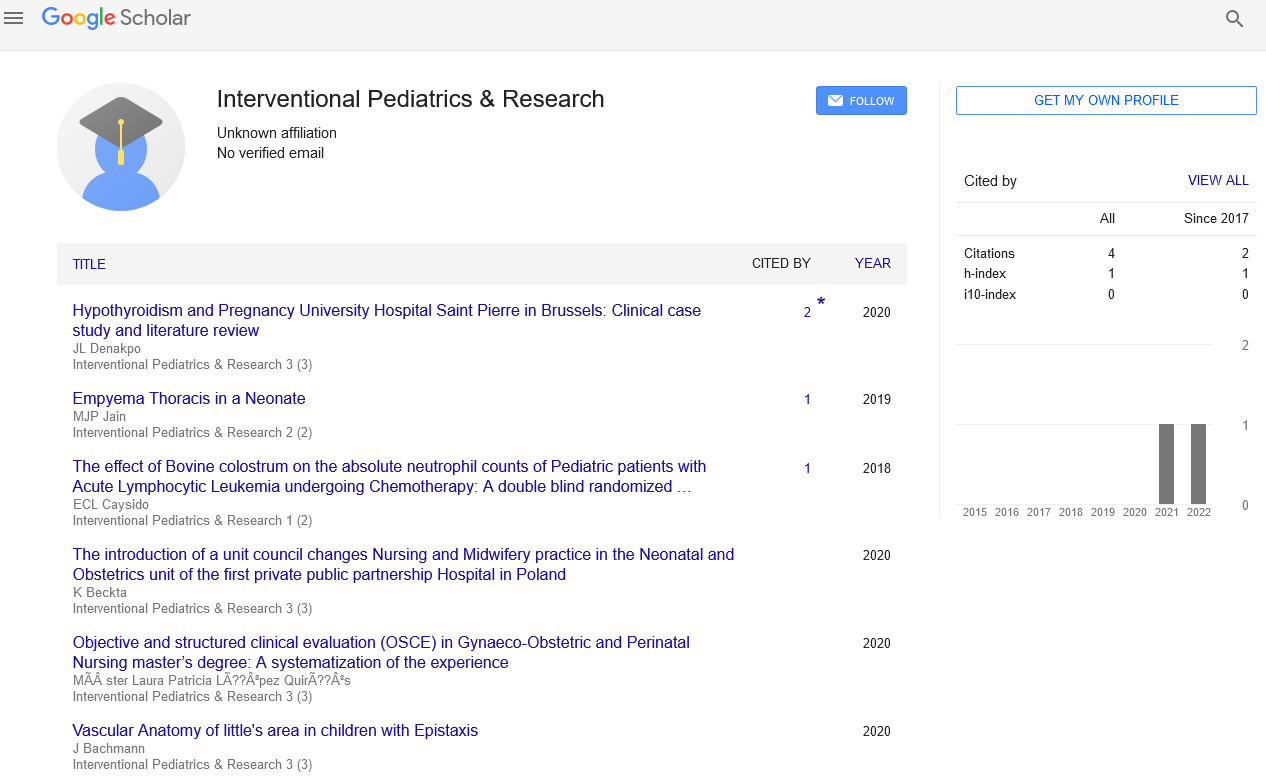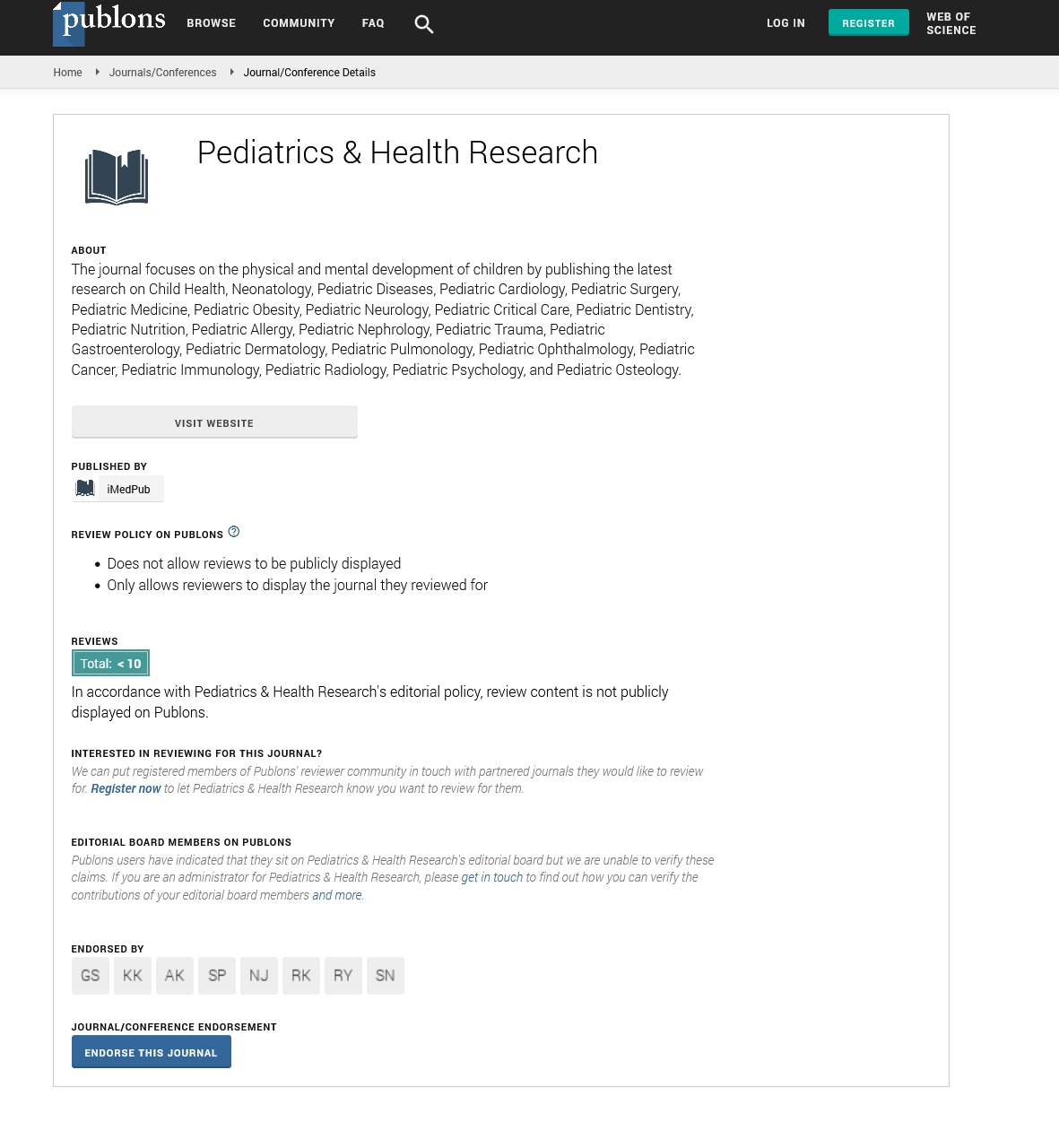Mini Review - Interventional Pediatrics & Research (2023) Volume 6, Issue 2
Children who have survived cancer develop cerebrovascular disease
Pater Jensen*
Department of Pediatric oncology interventions, Australia
Department of Pediatric oncology interventions, Australia
E-mail: Jensen_pe8@gmail.com
Received: 01-April-2023, Manuscript No. ipdr-23-94086; Editor assigned: 03-April-2023, Pre-QC No. ipdr-23- 94086 (PQ); Reviewed: 18-April-2023, QC No. ipdr-23-94086; Revised: 21-April-2023, Manuscript No. ipdr-23-94086 (R); Published: 28-April-2023, DOI: 10.37532/ ipdr.2023.6(2).16-18
Abstract
Sadly, irradiation is linked to adverse effects like stroke and other forms of cerebrovascular disease (CVD). Guidelines for screening survivors at risk for persistent or late squeal of cancer therapy have been developed by the Children’s Oncology Group (COG). This review outlines the specific patient groups at risk for early-onset stroke and provides a summary of the pathophysiology and relevant manifestations of radiation-induced cardiovascular disease. The reader will be informed that the COG monitoring recommendations are available, and when applicable, specific recommendations for screening and treatment will be highlighted
Introduction
There are currently 270,000 survivors of childhood cancer in the United States, including 1 in 640 adults between the ages of 20 and 392, 3 [1]. Unfortunately, many of these survivors face significant medical challenges. More than 60% of the 10,397 adult participants in the Childhood Cancer Survivor Study (CCSS), a large multi-institutional cohort of long-term childhood cancer survivors diagnosed between 1970 and 1986, have reported at least one chronic health condition, and nearly 30% have a severe or life-threatening condition at a relatively young mean age of 26.6 years. Unfavourable side effects of previous cancer treatment are frequently to blame for persistent health problems that can develop for many years after the initial treatment. Medical professionals will need to be familiar with the comorbidities that frequently affect this population as survivors of childhood cancer age and move from pediatric to adult care [2]. Congestive heart failure, coronary artery disease, stroke, seizures, and second malignant neoplasms have been identified in childhood cancer survivors at a significantly higher rate than anticipated when compared to the general population. Female breast cancer is the most common type of second malignant neoplasm. Albeit restorative radiation plays had a conspicuous impact in propelling the fix rate for the overwhelming majority youth malignant growths, harm to encompassing ordinary tissue might be significant [3]. Prior irradiation is known to increase the likelihood of developing cerebrovascular disease in adult cancer patients. The risk of cardiovascular disease (CVD) in younger patients receiving radiation therapy is less well understood [4]. The specific patient groups at risk for early-onset stroke are identified and the relevant pathophysiology and manifestations of radiation-induced cardiovascular disease are summarized in this review. Longterm follow-up recommendations for patients with a history of childhood cancer have also been compiled by the Children’s Oncology Group (COG), a collaborative international cooperative clinical trials group [5]. These recommendations are based on peer-reviewed literature.
Material and Methods
Cerebrovascular disease caused by radiation
Similar reports, typically focusing on a single case or a small series of cases, have since been published to bolster this phenomenon. The reported median latency period between RT and the diagnosis of steno-occlusive disease in this selected review is approximately three years, but the range is wide. The prevalence of steno-occlusive disease caused by radiation is unclear [6]. However, patients with suprasellar and/or chiasmatic lesions, such as germ cell tumors, optic gliomas, hypothalamic astrocytoma’s, and craniopharyngiomas, appear to be at greatest risk for this complication due to the fact that these tumors frequently require intense RT close to the circle of Willis. Additionally, moyamoya disease, a progressive occlusion of the internal carotid arteries with abnormal arterial collateral formation, can result in cerebral hypo perfusion in these patients. Moyamoya appears to be more common in children with NF1 who have been treated for optic pathway gliomas, and they may develop this vasculopathy earlier and with less radiation exposure than non-NF patients [7]. Occlusive vasculopathy has been identified in young adults decades after irradiation, despite the fact that moyamoya in the context of irradiation appears to develop primarily in the pediatric age group. Lastly, mineralizing macroangiopathy is a unique histopathology condition that causes calcification of the basal ganglia in small vessels. In a large autopsy study of children with leukaemia treated with cranial irradiation, mineralizing macroangiopathy was detected in 28 of 163 patients (17%) as early as 10 months after RT.40 The current COG Long- Term Follow-Up Guidelines recommend an annual neurologic examination for patients with a history of cranial irradiation of less than 18 Gy, which is the highest risk group for patients exposed to less than 50 Gy. When clinically necessary, a brain MRI with diffusion-weighted imaging and magnetic resonance angiography is recommended [8]. Because antiplatelet prophylaxis has not been shown to be beneficial for moyamoya or post irradiation occlusive cerebral vasculopathy, no definitive treatment recommendations are available.
Vascular abnormality/aneurysm
Similar to post radiation steno-occlusive disease, descriptive series and retrospective cohort analysis have primarily provided information regarding these abnormalities. With respect to cavernomas, the biggest series to date distinguished 10 of 297 pediatric mind growth patients (3.4%) who had fostered a cavernomas at a middle of 37 months after illumination. It’s possible that cavernomas development takes place sooner in patients who receive more than 30 Gy [9]. Regardless of the RT dose, telangiectasias were found in 20% of leukemia and brain tumor survivors. Telangiectasias and cavernous malformations typically show up by accident on follow-up neuroimaging, do not necessitate treatment, and carry a low risk. These lesions can occasionally be accompanied by seizures, headache, and bleeding, which may necessitate surgical intervention. Although they are thought to be a rare complication, radiation-induced intracranial aneurysms can be fatal. It has been widely reported how long it takes to detect an aneurysm after RT. No relationship be tween’s radiation portion and time to aneurysm disclosure has been clarified. After a haemorrhage, diagnosis is typically made retrospectively. Albeit no conclusive proposal can be given in regards to found unruptured aneurysms, treatment choices are accessible. The treatment-related vascular malformations and aneurysms are not specifically addressed in the current COG guidelines. However, the emergence of new neurologic findings in patients who have previously been exposed to cranial radiation ought to call for neuroimaging because these abnormalities have the potential to cause haemorrhage and/or the onset of seizures.
Conclusion
Adult neurologists need to be more aware of the potential for neurologic complications from previous oncologic treatment in this aging population, despite the limited literature on the subject. Neurologists are well-positioned to assist in the prevention of cerebrovascular accidents, to reduce the amount of testing that is unnecessary, and to enhance the survivors’ quality of life. To help care suppliers, the Gear-tooth has created rules for evaluating survivors in danger for steady or late squeal of disease treatment.
References
- Mariotto AB, Rowland JH, Yabroff KR et al. Long-term survivors of childhood cancers in the United States. Cancer Epidemiol Biomarkers Prev.18, 1033–1040 (2009).
- Bhatia S, Yasui Y, Robison LL et al. High risk of subsequent neoplasms continues with extended follow-up of childhood Hodgkin’s disease: report from the Late Effects Study Group. J Clin Oncol.21, 4386–4394 (2003).
- Smith GL, Smith BD, Buchholz TA et al. Cerebrovascular disease risk in older head and neck cancer patients after radiotherapy. J Clin Oncol.26, 5119–5125 (2008).
- Landier W, Bhatia S, Eshelman DA et al. Development of risk-based guidelines for pediatric cancer survivors: the Children’s Oncology Group Long-Term Follow-Up Guidelines from the Children’s Oncology Group Late Effects Committee and Nursing Discipline. J Clin Oncol.22, 4979–4990 (2004).
- Brown WR, Thore CR, Moody DM et al. Vascular damage after fractionated whole-brain irradiation in rats. Radiat Res.164, 662–668 (2005).
- Munter MW, Karger CP, Reith W et al. Delayed vascular injury after single high-dose irradiation in the rat brain: histologic Immunohistochemical and angiographic studies. Radiology.212, 475–482 (1999).
- Louis EL, McLoughlin MJ, Wortzman G. Chronic damage to medium and large arteries following irradiation. J Can Assoc Radiol.25, 94–104 (1974).
- King LJ, Hasnain SN, Webb JA et al. Asymptomatic carotid arterial disease in young patients following neck radiation therapy for Hodgkin lymphoma. Radiology.213, 167–172 (1999).
- Beyer RA, Paden P, Sobel DF et al. Moyamoya pattern of vascular occlusion after radiotherapy for glioma of the optic chiasm. Neurology.36, 1173–1178 (1986).
Indexed at, Google Scholar, Crossref
Indexed at, Google Scholar, Crossref
Indexed at, Google Scholar, Crossref
Indexed at, Google Scholar, Crossref
Indexed at, Google Scholar, Crossref
Indexed at, Google Scholar, Crossref
Indexed at, Google Scholar, Crossref


